Connected Vehicles and Digital Infrastructures: A Framework for Assessing the Port Efficiency
Abstract
1. Introduction
- proposing a generic architecture to integrate information technology into physical infrastructures;
- suggesting a generic framework to deal with incoming demand at the terminal infrastructure;
- testing a solution to improve terminal efficiency operations on the landside;
- testing the capability of the system to deal with the demand using synthetic performance indicators;
- studying a valuable tactical solution to manage both automated/connected and traditional vehicles.
2. Literature Review
3. Architecture and Operational Framework
3.1. Development of a General Architecture
- the transport companies send their daily plan to the terminal operator, pointing out the nature of the freight (dangerous, perishable, general merchandise, ...); they have to confirm the number of trucks, the platoon scheme, the desired shipping company and the naval service to board on;
- vehicles receive routing information from smart road devices installed in the corridors and the terminal cloud system through a communication protocol, the same reports about traffic conditions around the infrastructure, queue estimation in the buffer area, vessel approaching and final direction;
- the planned route, the next vessel berthing and available space are stored in the system; moreover, to avoid long waiting, the system coordinates approaching and manoeuvres as well corridors assignment;
- the terminal area is provided with a stable cloud monitoring system equipped with roadside units and an optimization traffic control system that enables communication highlighting yard occupation (of the buffer area) and the number of vehicles waiting for the embankment.
3.2. Operation Framework
4. Simulation Test
4.1. General Approach
4.2. Case Study
4.3. Experimental Analysis
5. Discussion
Author Contributions
Funding
Institutional Review Board Statement
Informed Consent Statement
Data Availability Statement
Acknowledgments
Conflicts of Interest
Abbreviations
| ANPR | Automatic Number Plate Recognition |
| AVG | Automatic Guided Vehicles |
| ADAS | Advanced Driver Assist Systems |
| DES | Discrete-Event Simulation |
| DSCR | Dedicated Short-Range Communication |
| FIFO | First-In-First-Out |
| GA | Genetic Algorithm |
| ITS | Intelligent Transportation Systems |
| KPI | Key Performance Indicator |
| SAE | Society of Automobile Engineers |
| TAS | Truck Arrival System |
| TEN-T | Trans European Transport Network |
| TSMS | Time Slot Management System |
| V2I | Vehicle-to-Infrastructure |
| V2V | Vehicle-to-Vehicle |
References
- Comi, A.; Nuzzolo, A. Exploring the relationships between e-shopping attitudes and urban freight transport. Transp. Res. Procedia 2016, 12, 399–412. [Google Scholar] [CrossRef]
- Nogueira, G.P.M.; de Assis Rangel, J.J.; Croce, P.R.; Peixoto, T.A. The environmental impact of fast delivery B2C e-commerce in outbound logistics operations: A simulation approach. Clean. Logist. Supply Chain 2022, 5, 100070. [Google Scholar] [CrossRef]
- Di Gangi, M.; Polimeni, A.; Belcore, O.M. Freight Distribution in Small Islands: Integration between Naval Services and Parcel Lockers. Sustainability 2023, 15, 7535. [Google Scholar] [CrossRef]
- European Commission. Roadmap to a Single European Transport Area—Towards a Competitive and Resource Efficient Transport System, EUR-Lex 2011, 52011DC0144. Available online: https://eur-lex.europa.eu/LexUriServ/LexUriServ.do?uri=COM:2011:0144:FIN:en:PDF (accessed on 3 April 2023).
- Comi, A.; Polimeni, A. Assessing the Potential of Short Sea Shipping and the Benefits in Terms of External Costs: Application to the Mediterranean Basin. Sustainability 2020, 12, 5383. [Google Scholar] [CrossRef]
- Assoporti. L’Italia dei Porti. 2022. Available online: https://www.assoporti.it (accessed on 17 May 2023).
- Kim, E.; Kim, Y.; Park, J. The Necessity of Introducing Autonomous Trucks in Logistics 4.0. Sustainability 2022, 14, 3978. [Google Scholar] [CrossRef]
- Shaout, A.; Colella, D.; Awad, S. Advanced Driver Assistance Systems - Past, present and future. In Proceedings of the 2011 Seventh International Computer Engineering Conference (ICENCO’2011), Cairo, Egypt, 27–28 December 2011; pp. 72–82. [Google Scholar] [CrossRef]
- Kukkala, V.K.; Tunnell, J.; Pasricha, S.; Bradley, T. Advanced Driver-Assistance Systems: A Path Toward Autonomous Vehicles. IEEE Consum. Electron. Mag. 2018, 7, 18–25. [Google Scholar] [CrossRef]
- SAE International. Taxonomy and Definitions for Terms Related to Driving Automation Systems for On-Road Motor Vehicles; SAE International: Warrendale, PA, USA, 2021. [Google Scholar]
- Pereira, A.M.; Anany, H.; Přibyl, O.; Přikryl, J. Automated vehicles in smart urban environment: A review. In Proceedings of the 2017 Smart City Symposium Prague (SCSP), Prague, Czech Republic, 25–26 May 2017; pp. 1–8. [Google Scholar]
- Guanetti, J.; Kim, Y.; Borrelli, F. Control of connected and automated vehicles: State of the art and future challenges. Annu. Rev. Control 2018, 45, 18–40. [Google Scholar] [CrossRef]
- Di Salvo, R.; Galletta, A.; Belcore, O.M.; Villari, M. Modeling Users’ Performance: Predictive Analytics in an IoT Cloud Monitoring System. In Proceedings of the Service-Oriented and Cloud Computing: 8th IFIP WG 2.14 European Conference, ESOCC 2020, Heraklion, Crete, Greece, 28–30 September 2020; pp. 149–158. [Google Scholar]
- Shladover, S.E. Connected and automated vehicle systems: Introduction and overview. J. Intell. Transp. Syst. 2018, 22, 190–200. [Google Scholar] [CrossRef]
- Qin, K.; Wang, B.; Zhang, H.; Ma, W.; Yan, M.; Wang, X. Research on Application and Testing of Autonomous Driving in Ports; Technical Report; SAE International: Warrendale, PA, USA, 2020. [Google Scholar]
- Fiedler, R.; Bosse, C.; Gehlken, D.; Brümmerstedt, K.; Burmeister, H. Autonomous Vehicles’ Impact on Port Infrastructure Requirements; Fraunhofer Center for Maritime Logistics and Services CML: Hamburg, Germany, 2019. [Google Scholar]
- Fishman, G.S. Discrete-Event Simulation; Springer: New York, NY, USA, 2001. [Google Scholar] [CrossRef]
- Preston, G.C.; Horne, P.; Scaparra, M.P.; O’Hanley, J.R. Masterplanning at the Port of Dover: The use of discrete-event simulation in managing road traffic. Sustainability 2020, 12, 1067. [Google Scholar] [CrossRef]
- Iannone, R.; Miranda, S.; Prisco, L.; Riemma, S.; Sarno, D. Proposal for a flexible discrete event simulation model for assessing the daily operation decisions in a Ro–Ro terminal. Simul. Model. Pract. Theory 2016, 61, 28–46. [Google Scholar] [CrossRef]
- Keceli, Y. A simulation model for gate operations in multi-purpose cargo terminals. Marit. Policy Manag. 2016, 43, 945–958. [Google Scholar] [CrossRef]
- Özkan, E.D.; Nas, S.; Güler, N. Capacity analysis of Ro-Ro terminals by using simulation modeling method. Asian J. Shipp. Logist. 2016, 32, 139–147. [Google Scholar] [CrossRef]
- Abourraja, M.N.; Kringos, N.; Meijer, S. Exploiting simulation model potential in investigating handling capacity of Ro-Ro terminals: The case study of Norvik seaport. Simul. Model. Pract. Theory 2022, 117, 102513. [Google Scholar] [CrossRef]
- Abourraja, M.N.; Rouky, N.; Kornevs, M.; Meijer, S.; Kringos, N. A simulation-based decision support framework devoted to Ro-Ro terminals: Design, implementation and evaluation. Comput. Ind. Eng. 2023, 180, 109248. [Google Scholar] [CrossRef]
- Park, S.H.; Hwang, J.; Yun, S.; Kim, S. Automatic Guided Vehicles Introduction Impacts to Roll-On/Roll-Off Terminals: Simulation and Cost Model Analysis. J. Adv. Transp. 2022, 2022, 6062840. [Google Scholar] [CrossRef]
- Muravev, D.; Aksoy, S.; Rakhmangulov, A.; Aydogdu, Y.V. Comparing model development in discrete event simulation on Ro-Ro terminal example. Int. J. Logist. Syst. Manag. 2016, 24, 283–297. [Google Scholar]
- Sharif, O.; Huynh, N.; Vidal, J.M. Application of El Farol model for managing marine terminal gate congestion. Res. Transp. Econ. 2011, 32, 81–89. [Google Scholar] [CrossRef]
- Parola, F.; Sciomachen, A. Modal split evaluation of a maritime container terminal. Marit. Econ. Logist. 2009, 11, 77–97. [Google Scholar] [CrossRef]
- Van Vianen, T.; Ottjes, J.; Lodewijks, G. Simulation-based rescheduling of the stacker–reclaimer operation. J. Comput. Sci. 2015, 10, 149–154. [Google Scholar] [CrossRef]
- Jovanovic, R. Optimizing truck visits to container terminals with consideration of multiple drays of individual drivers. J. Optim. 2018, 2018, 5165124. [Google Scholar] [CrossRef]
- Azab, A.; Karam, A.; Eltawil, A. A simulation-based optimization approach for external trucks appointment scheduling in container terminals. Int. J. Model. Simul. 2020, 40, 321–338. [Google Scholar] [CrossRef]
- Neagoe, M.; Hvolby, H.H.; Taskhiri, M.S.; Turner, P. Using discrete-event simulation to compare congestion management initiatives at a port terminal. Simul. Model. Pract. Theory 2021, 112, 102362. [Google Scholar] [CrossRef]
- Nadi, A.; Nugteren, A.; Snelder, M.; van Lint, J.; Rezaei, J. Advisory-Based Time Slot Management System to Mitigate Waiting Time at Container Terminal Gates. Transp. Res. Rec. 2022, 2676, 656–669. [Google Scholar] [CrossRef]
- Srisurin, P.; Pimpanit, P.; Jarumaneeroj, P. Evaluating the long-term operational performance of a large-scale inland terminal: A discrete event simulation-based modeling approach. PLoS ONE 2022, 17, e0278649. [Google Scholar] [CrossRef]
- Schroër, H.J.; Corman, F.; Duinkerken, M.B.; Negenborn, R.R.; Lodewijks, G. Evaluation of inter terminal transport configurations at Rotterdam Maasvlakte using discrete event simulation. In Proceedings of the Winter Simulation Conference, Savannah, GA, USA, 7–10 December 2014; pp. 1771–1782. [Google Scholar] [CrossRef]
- Rusca, F.; Popa, M.; Rosca, E.; Rusca, A. Simulation model for maritime container terminal. Transp. Probl. 2018, 13, 47–54. [Google Scholar] [CrossRef]
- Cartenì, A.; de Luca, S. Tactical and strategic planning for a container terminal: Modelling issues within a discrete event simulation approach. Simul. Model. Pract. Theory 2012, 21, 123–145. [Google Scholar] [CrossRef]
- Cimpeanu, R.; Devine, M.T.; O’Brien, C. A simulation model for the management and expansion of extended port terminal operations. Transp. Res. Part E Logist. Transp. Rev. 2017, 98, 105–131. [Google Scholar] [CrossRef]
- Li, N.; Chen, G.; Govindan, K.; Jin, Z. Disruption management for truck appointment system at a container terminal: A green initiative. Transp. Res. Part D Transp. Environ. 2018, 61, 261–273. [Google Scholar] [CrossRef]
- Alvarez, J.F.; Longva, T.; Engebrethsen, E.S. A methodology to assess vessel berthing and speed optimization policies. Marit. Econ. Logist. 2010, 12, 327–346. [Google Scholar] [CrossRef]
- Triska, Y.; Frazzon, E.M.; Silva, V.M.D. Proposition of a simulation-based method for port capacity assessment and expansion planning. Simul. Model. Pract. Theory 2020, 103, 102098. [Google Scholar] [CrossRef]
- Guan, C.; Liu, R. Container terminal gate appointment system optimization. Marit. Econ. Logist. 2009, 11, 378–398. [Google Scholar] [CrossRef]
- Guan, C.Q.; Liu, R. Modeling gate congestion of marine container terminals, truck waiting cost, and optimization. Transp. Res. Rec. 2009, 2100, 58–67. [Google Scholar] [CrossRef]
- Assumma, V.; Vitetta, A. Microsimulation models in intermodal container terminals: Ordinary and perturbed conditions. In Proceedings of the 7th International Industrial Simulation Conference, Istanbul, Turkey, 13–16 July 2009; pp. 196–200. [Google Scholar]
- Fleming, M.; Huynh, N.; Xie, Y. Agent-based simulation tool for evaluating pooled queue performance at marine container terminals. Transp. Res. Rec. 2013, 2330, 103–112. [Google Scholar] [CrossRef]
- Chen, G.; Govindan, K.; Yang, Z. Managing truck arrivals with time windows to alleviate gate congestion at container terminals. Int. J. Prod. Econ. 2013, 141, 179–188. [Google Scholar] [CrossRef]
- Ambrosino, D.; Peirano, L. Truck Arrival Management At Maritime Container Terminals. ECMS 2016, 2016, 114–120. [Google Scholar]
- Minh, C.C.; Noi, N.V. Optimising truck arrival management and number of service gates at container terminals. Marit. Bus. Rev. 2023, 8, 18–31. [Google Scholar] [CrossRef]
- Minh, C.C.; Huynh, N. Optimal design of container terminal gate layout. Int. J. Shipp. Transp. Logist. 2017, 9, 640–650. [Google Scholar] [CrossRef]
- Yang, Z.; Chen, K.; Notteboom, T. Optimal design of container liner services: Interactions with the transport demand in ports. Marit. Econ. Logist. 2012, 14, 409–434. [Google Scholar] [CrossRef]
- Di Gangi, M.; Belcore, O.M. Risk reduction in transport system in emergency conditions: A framework for decision support systems. Saf. Secur. Eng. IX 2022, 206, 299. [Google Scholar] [CrossRef]
- Di Gangi, M.; Marco Belcore, O.; Polimeni, A. An Overview on Decision Support Systems for Risk Management in Emergency Conditions: Present, Past and Future Trends. Int. J. Transp. Dev. Integr. 2023, 7, 77–92. [Google Scholar] [CrossRef]
- De Vita, F.; Nocera, G.; Belcore, O.M.; Polimeni, A.; Longo, F.; Bruneo, D.; di Gangi, M. Traffic Condition Estimation at the Smart City Edge using Deep Learning: A Ro-Pax Terminal Case Study. In Proceedings of the 2022 IEEE International Smart Cities Conference (ISC2), Paphos, Cyprus, 26–29 September 2022; pp. 1–7. [Google Scholar] [CrossRef]
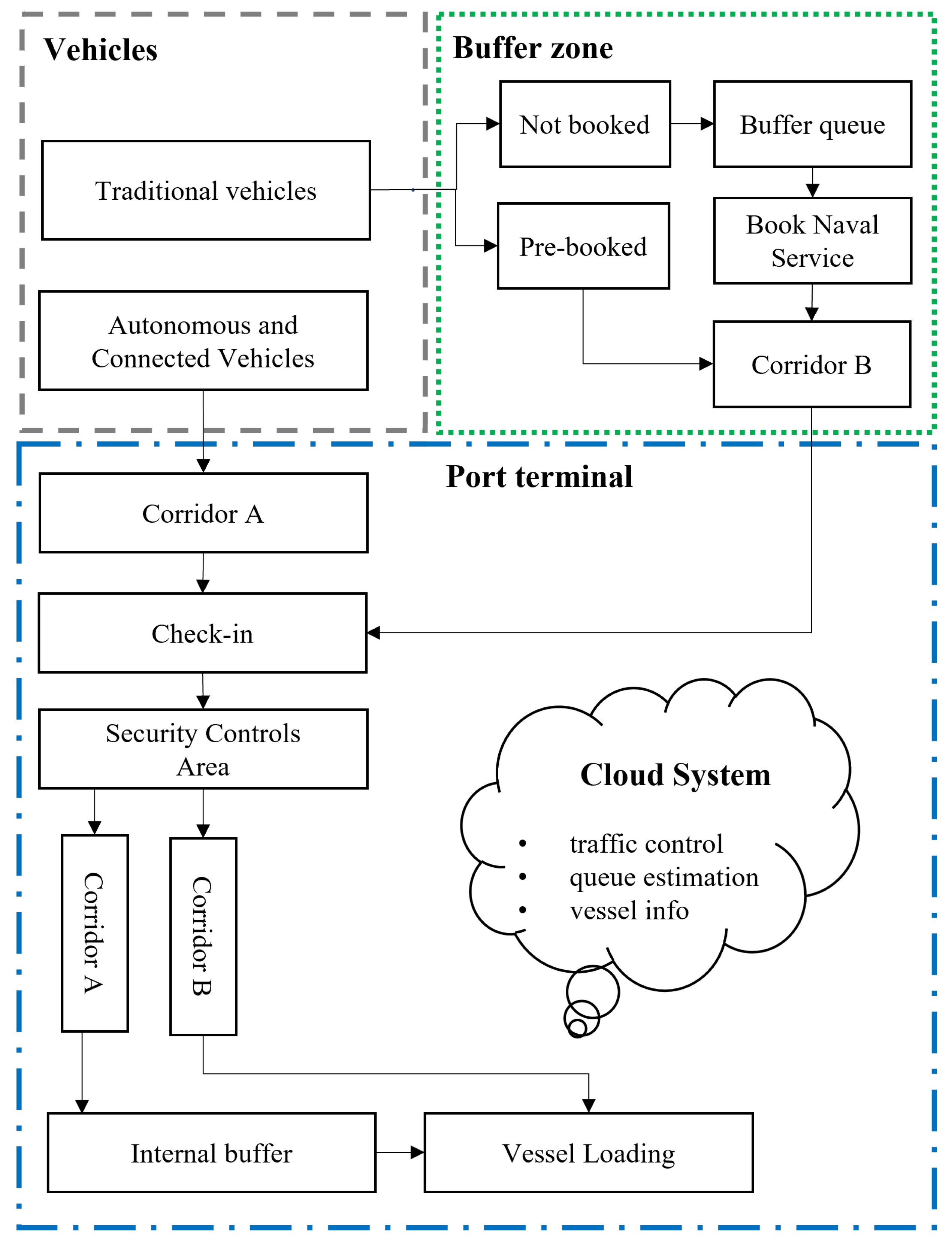
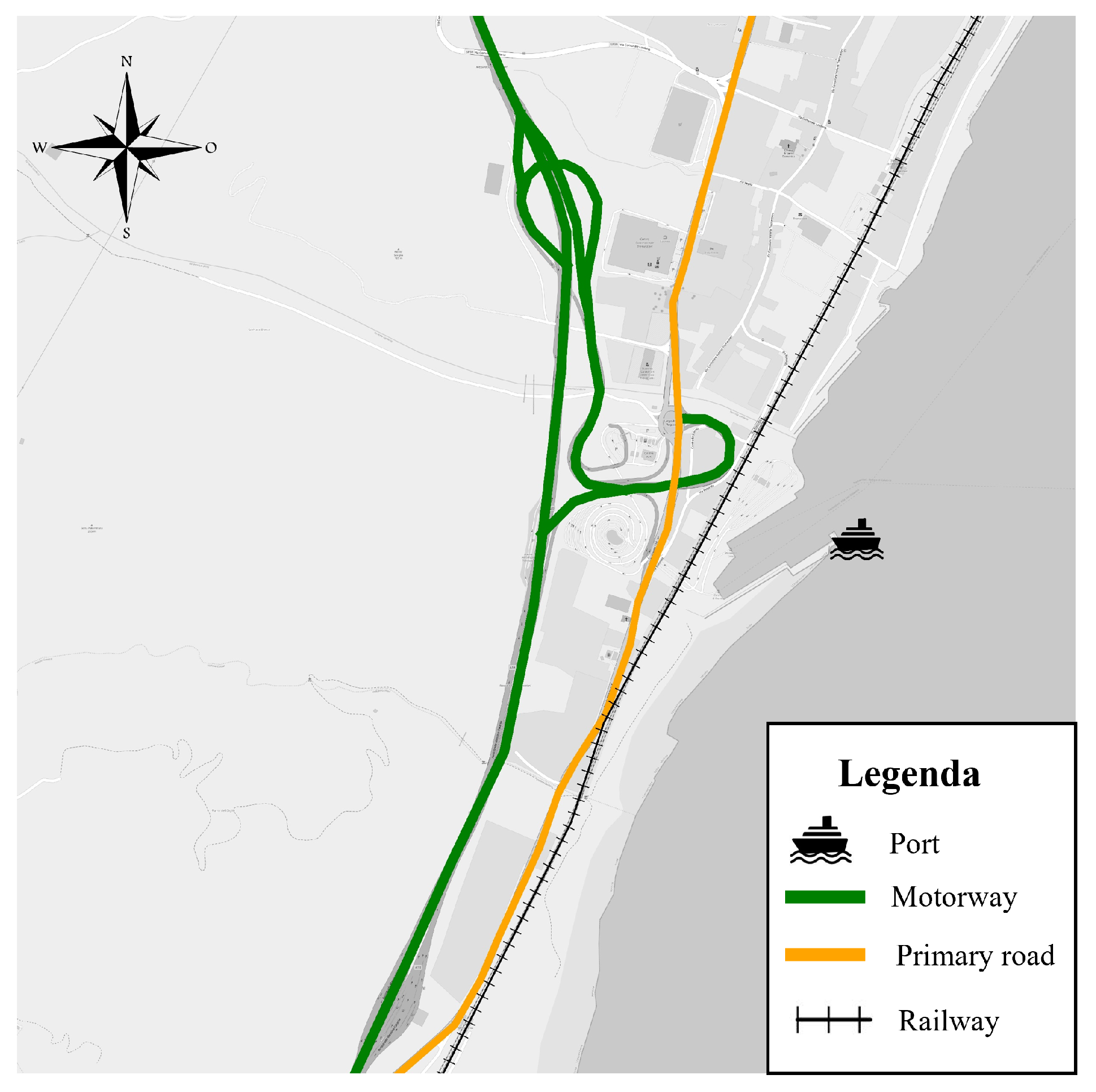
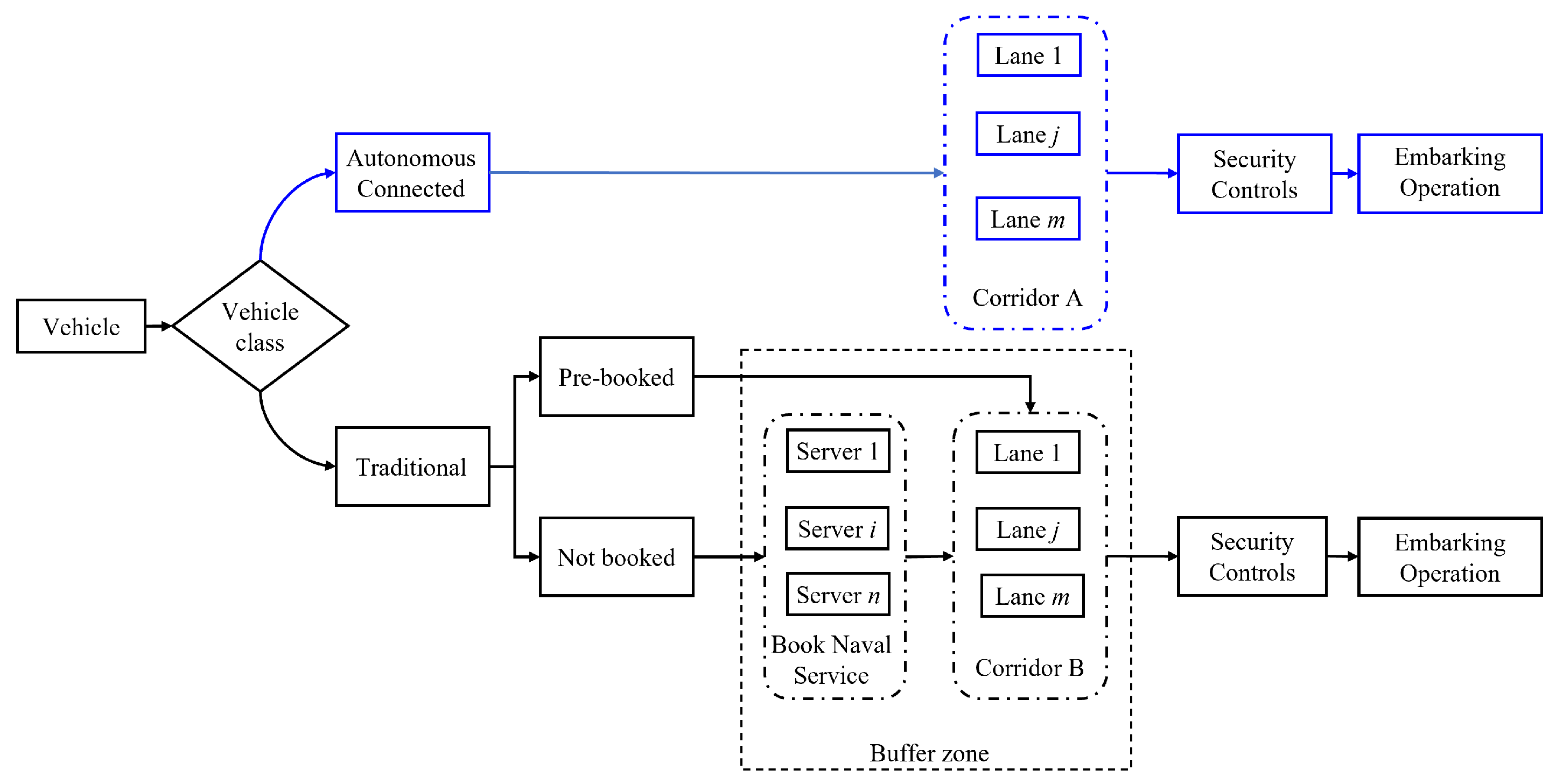
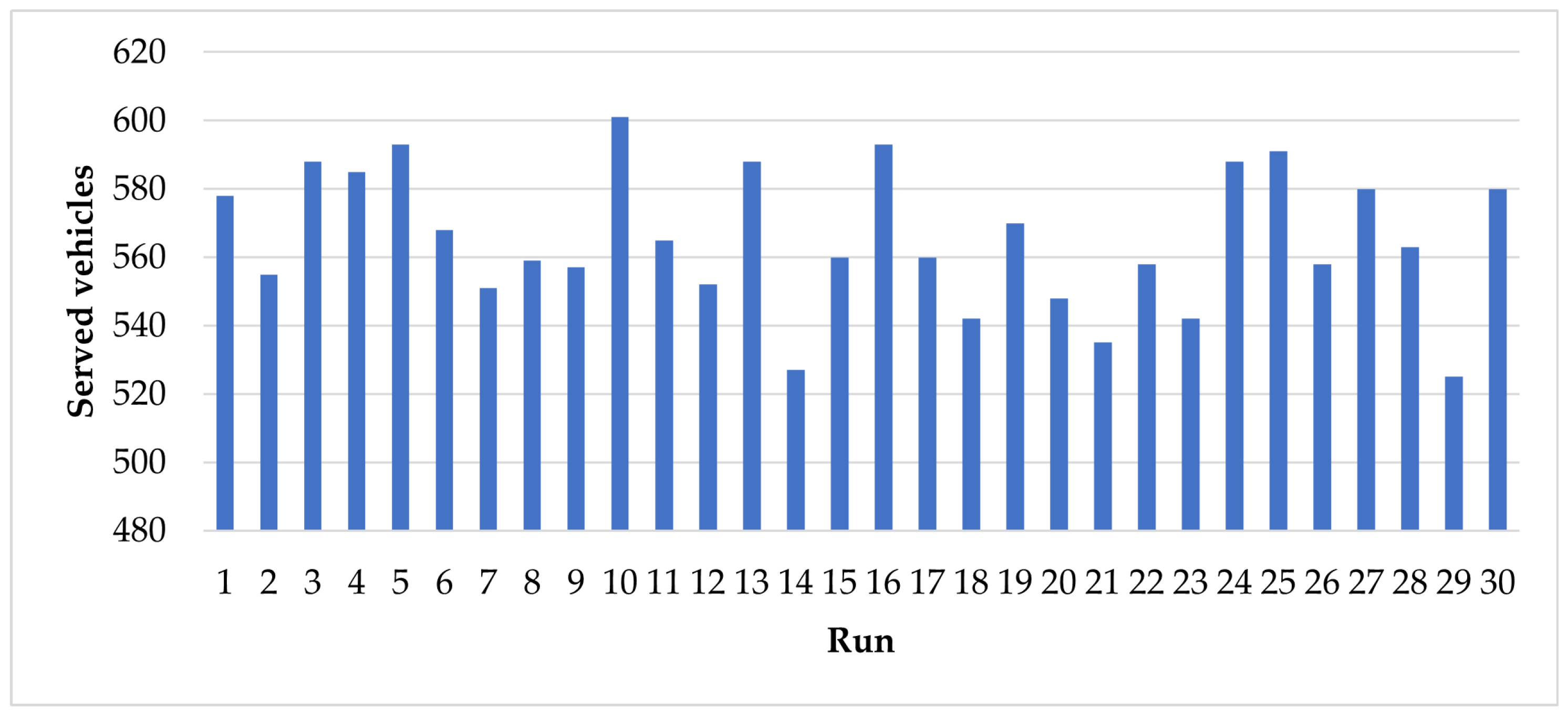
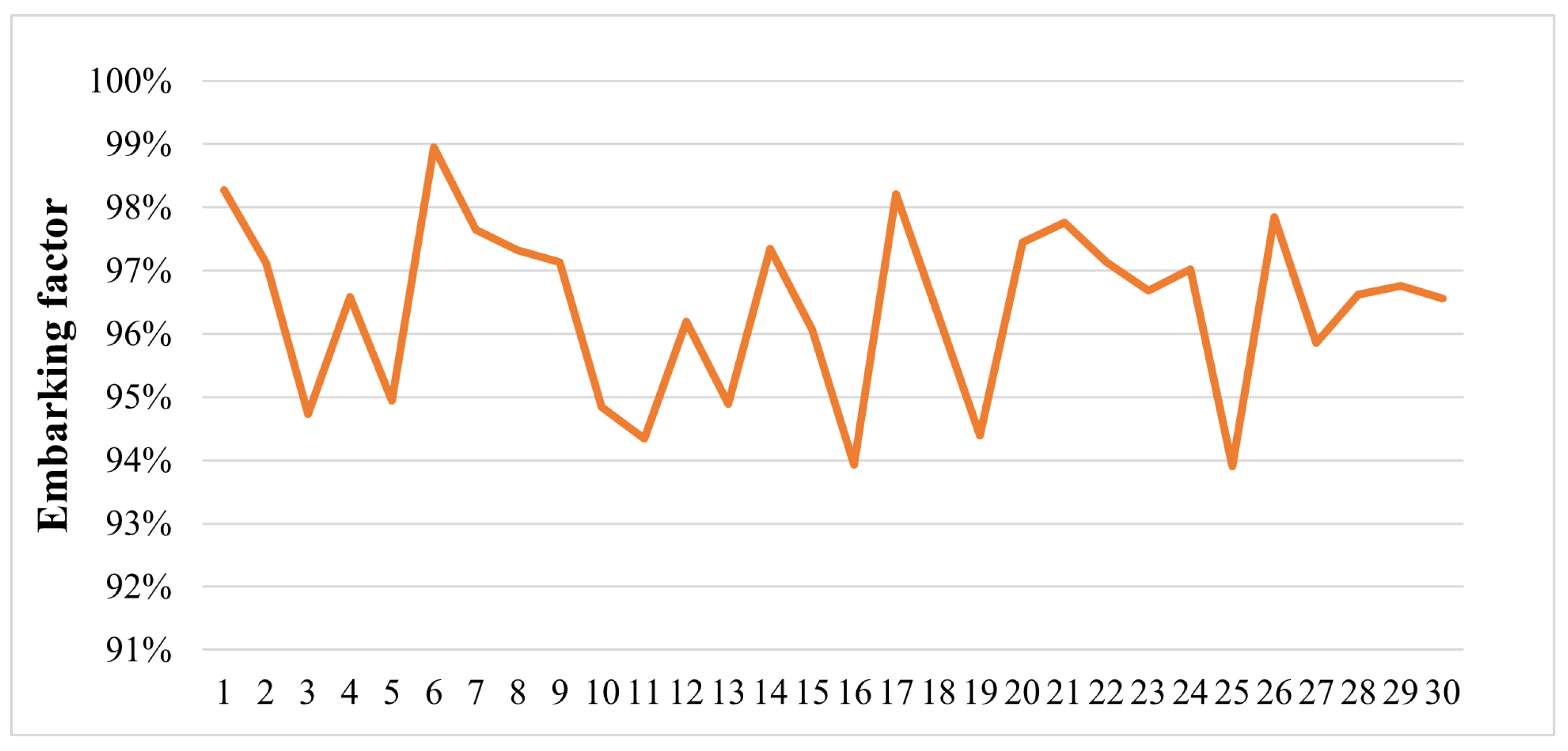
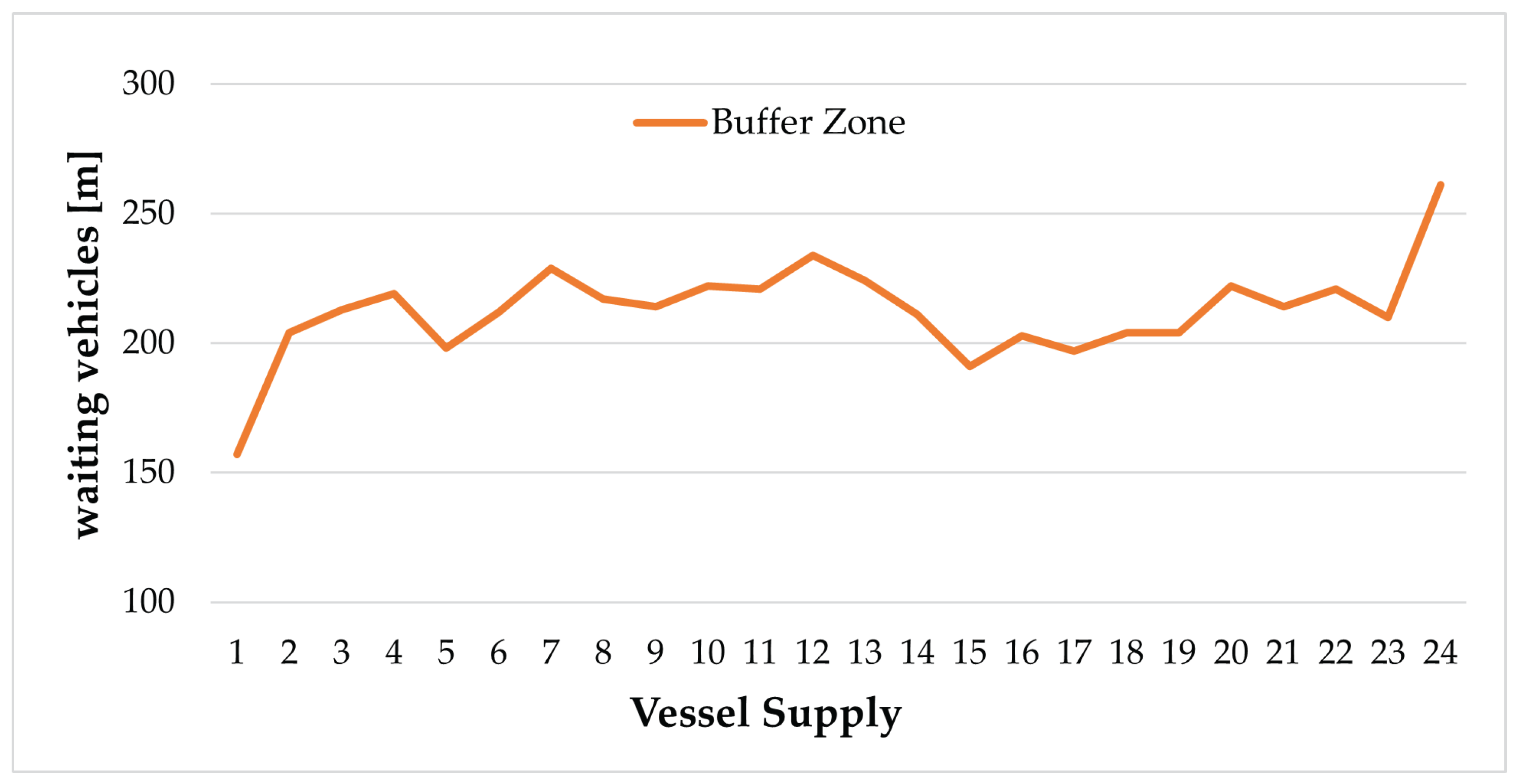

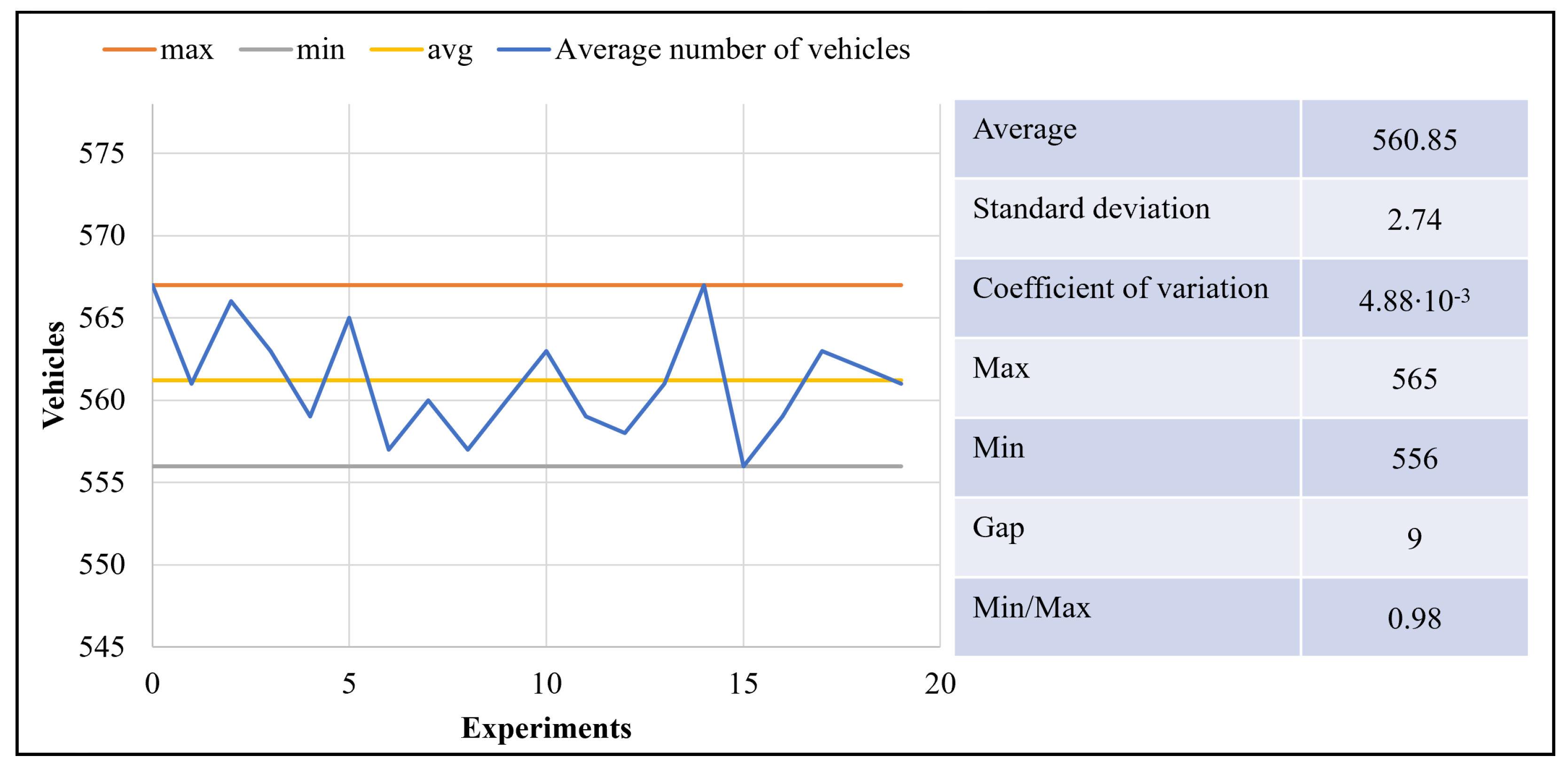
| Paper | Terminal | Simulation Approach | Software | Model Scope |
|---|---|---|---|---|
| Preston et al. [18] | ro-ro | DES | not stated | Planning; Capacity |
| Iannone et al. [19] | ro-ro | DES | ARENA | Planning Areas |
| Kaceli [20] | ro-ro | DES | ARENA | Gate; Yard Capacity |
| Muravev et al. [25] | ro-ro | DES | ARENA; AnyLogic | Scehduling; Capacity |
| Ozkan et al. [21] | ro-ro | DES | not stated | Sched.; Coordination |
| Abourraja et al. [22,23] | ro-ro | DES | not stated | Bert; Yard Capacity |
| Park et al. [24] | ro-ro | DES | not stated | AVGs Introduction |
| Sharif et al. [26] | ro-ro | Agent-Based | NetLogo | Capacity; Info |
| van Vianen et al. [28] | Multi-Modal | DES | not stated | Stackers operations |
| Parola and Sciomachen [27] | Multi Modal | DES | Witness | Coord. Modal Shift |
| Jovanocic [29] | Container | DES | not stated | Truck Arrivals System |
| Azab et al. [30] | Container | DES | FlexSim CT | TAS; Congestion |
| Neagoe et al. [31] | Container | DES | Python | TAS; Handling |
| Nadi et al. [32] | Container | DES | not stated | TSMS |
| Srisurin et al. [33] | Container | DES | SIMIO | Slot Allocation; Hand. |
| Schoroer et al. [34] | Container | DES | Delphi | Internal Transport |
| Rusca et al. [35] | Container | DES | ARENA | Planning; Capacity |
| Carteni and De Luca [36] | Container | DES | Witness | Planning; Capacity |
| Cimpeanu et al. [37] | Container | DES | Witness | Planning; Berth Occ. |
| Li et al. [38] | Container | DES | not stated | Bert; Yard Capacity |
| Alvarez et al. [39] | Container | DES | C ++ | Bert; Yard Capacity |
| Triska et al. [40] | Container | Monte Carlo | MatLab | Bert; Gate; Storage |
| Guan and Liu [41,42] | Container | Queue Theory | not stated | Gate Capacity; Servers |
| Assumma and Vitetta [43] | Container | Agent-based | ARENA | Planning |
| Fleming et al. [44] | Container | Agent-based | NetLogo | Planning; Capacity |
| Chen et al. [45] | Container | Genetic Algorithm | not stated | TAS |
| Ambrosino and Peirano [46] | Container | Linear Optimization | C# | TAS |
| Mihn et al. [47] | Container | Genetic Algorithm | not stated | TAS |
| Minh and Huynh [48] | Container | Genetic Algorithm | not stated | Congestion |
| Yang et al. [49] | Container | Queue Theory | not stated | Slot Allocation; Waterway |
| Scenario Outputs 1 | Automated/Connected | Pre-Booked | Not Booked |
|---|---|---|---|
| Time in system (min) | 15’:00” ± 0’:50” | 22’:00” ± 1’:30” | 32’:00” ± 4’:45” |
| Served vehicles (n) | 169 | 256 | 136 |
| Scenario Outputs 1 | Automated/Connected | Pre-Booked | Not Booked |
|---|---|---|---|
| Waiting Time | 12’:45” | 16’:24” | 22’:36” |
Disclaimer/Publisher’s Note: The statements, opinions and data contained in all publications are solely those of the individual author(s) and contributor(s) and not of MDPI and/or the editor(s). MDPI and/or the editor(s) disclaim responsibility for any injury to people or property resulting from any ideas, methods, instructions or products referred to in the content. |
© 2023 by the authors. Licensee MDPI, Basel, Switzerland. This article is an open access article distributed under the terms and conditions of the Creative Commons Attribution (CC BY) license (https://creativecommons.org/licenses/by/4.0/).
Share and Cite
Belcore, O.M.; Di Gangi, M.; Polimeni, A. Connected Vehicles and Digital Infrastructures: A Framework for Assessing the Port Efficiency. Sustainability 2023, 15, 8168. https://doi.org/10.3390/su15108168
Belcore OM, Di Gangi M, Polimeni A. Connected Vehicles and Digital Infrastructures: A Framework for Assessing the Port Efficiency. Sustainability. 2023; 15(10):8168. https://doi.org/10.3390/su15108168
Chicago/Turabian StyleBelcore, Orlando Marco, Massimo Di Gangi, and Antonio Polimeni. 2023. "Connected Vehicles and Digital Infrastructures: A Framework for Assessing the Port Efficiency" Sustainability 15, no. 10: 8168. https://doi.org/10.3390/su15108168
APA StyleBelcore, O. M., Di Gangi, M., & Polimeni, A. (2023). Connected Vehicles and Digital Infrastructures: A Framework for Assessing the Port Efficiency. Sustainability, 15(10), 8168. https://doi.org/10.3390/su15108168








